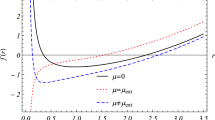Abstract
We introduce the quasi-topological electromagnetism which is defined to be the squared norm of the topological 4-form F ∧ F. A salient property is that its energy-momentum tensor is of the isotropic perfect fluid with the pressure being precisely the opposite to its energy density. It can thus provide a model for dark energy. We study its application in both black hole physics and cosmology. The quasi-topological term has no effect on the purely electric or magnetic Reissner-Nordström black holes, the dyonic solution is however completely modified. We find that the dyonic black holes can have four real horizons. For suitable parameters, the black hole can admit as many as three photon spheres, with one being stable. Another intriguing property is that although the quasi-topological term breaks the electromagnetic duality, the symmetry emerges in the on-shell action in the Wheeler-DeWitt patch. In cosmology, we demonstrate that the quasi-topological term alone is equivalent to a cosmological constant, but the model provides a mechanism for the dark energy to couple with other types of matter. We present a concrete example of the quasi-topological electromagnetism coupled to a scalar field that admits the standard FLRW cosmological solutions.
Similar content being viewed by others
References
M. Born, and L. Infeld, Proc. R. Soc. A-Math. Phys. Eng. Sci. 144, 425 (1934).
J. Oliva, and S. Ray, Class. Quantum Grav. 27, 225002 (2010), arXiv: 1003.4773.
R. C. Myers, and B. Robinson, J. High Energ. Phys. 2010(8), 67 (2010), arXiv: 1003.5357.
M. H. Dehghani, A. Bazrafshan, R. B. Mann, M. R. Mehdizadeh, M. Ghanaatian, and M. H. Vahidinia, Phys. Rev. D 85, 104009 (2012), arXiv: 1109.4708.
Y. Z. Li, H. S. Liu, and H. Lü, J. High Energ. Phys. 2018(2), 166 (2018), arXiv: 1708.07198.
B. Wang, E. Abdalla, F. Atrio-Barandela, and D. Pavón, Rep. Prog. Phys. 79, 096901 (2016), arXiv: 1603.08299.
G. W. Horndeski, J. Math. Phys. 17, 1980 (1976).
O. Goldoni, and M. F. A. da Silva, in Energy Conditions for Electromagnetic Field in Presence of Cosmological Constant: Proceedings of the 5th International School on Field Theory and Gravitation, Cuiab¢ city, Brazil, April 20–24, 2009.
C. Gao, Y. Lu, S. Yu, and Y. G. Shen, Phys. Rev. D 97, 104013 (2018), arXiv: 1711.00996.
J. H. Horne, and G. T. Horowitz, Nucl. Phys. B 399, 169 (1993).
K. Lee, and E. J. Weinberg, Phys. Rev. Lett. 73, 1203 (1994).
G. W. Gibbons, and R. E. Kallosh, Phys. Rev. D 51, 2839 (1995).
K. Lee, V. P. Nair, and E. J. Weinberg, Phys. Rev. Lett. 68, 1100 (1992).
Q. Q. Zhao, Y. Z. Li, and H. Lu, Phys. Rev. D 98, 124001 (2018), arXiv: 1809.04616.
H. Lu, Z. L. Wang, and Q. Q. Zhao, Phys. Rev. D 99, 101502 (2019), arXiv: 1901.02894.
D. Kastor, S. Ray, and J. Traschen, Class. Quantum Grav. 26, 195011 (2009), arXiv: 0904.2765.
M. Cvetič, G. W. Gibbons, D. Kubizňák, and C. N. Pope, Phys. Rev. D 84, 024037 (2011), arXiv: 1012.2888.
C. M. Claudel, K. S. Virbhadra, and G. F. R. Ellis, J. Math. Phys. 42, 818 (2001).
S. Hod, Phys. Rev. D 84, 124030 (2011), arXiv: 1112.3286.
S. Hod, Phys. Rev. D 84, 104024 (2011), arXiv: 1201.0068.
M. Cvetič, G. W. Gibbons, and C. N. Pope, Phys. Rev. D 94, 106005 (2016), arXiv: 1608.02202.
Y. Koga, and T. Harada, Phys. Rev. D 94, 044053 (2016), arXiv: 1601.07290.
S. Deser, and C. Teitelboim, Phys. Rev. D 13, 1592 (1976).
S. Deser, J. Phys. A-Math. Gen. 15, 1053 (1982).
S. Deser, M. Henneaux, and C. Teitelboim, Phys. Rev. D 55, 826 (1997).
E. Cremmer, B. Julia, H. Lü, and C. N. Pope, Nucl. Phys. B 535, 242 (1998).
A. R. Brown, D. A. Roberts, L. Susskind, B. Swingle, and Y. Zhao, Phys. Rev. Lett. 116, 191301 (2016).
A. R. Brown, D. A. Roberts, L. Susskind, B. Swingle, and Y. Zhao, Phys. Rev. D 93, 086006 (2016), arXiv: 1512.04993.
K. Goto, H. Marrochio, R. C. Myers, L. Queimada, and B. Yoshida, J. High Energ. Phys. 2019(2), 160 (2019), arXiv: 1901.00014.
H. S. Liu, and H. Lu, J. High Energ. Phys. 2019(9), 102 (2019).
L. Lehner, R. C. Myers, E. Poisson, and R. D. Sorkin, Phys. Rev. D 94, 084046 (2016), arXiv: 1609.00207.
S. Li, H. Lu, and H. Wei, J. High Energ. Phys. 2016(7), 4 (2016), arXiv: 1606.02733.
Author information
Authors and Affiliations
Corresponding author
Rights and permissions
About this article
Cite this article
Liu, HS., Mai, ZF., Li, YZ. et al. Quasi-topological electromagnetism: Dark energy, dyonic black holes, stable photon spheres and hidden electromagnetic duality. Sci. China Phys. Mech. Astron. 63, 240411 (2020). https://doi.org/10.1007/s11433-019-1446-1
Received:
Accepted:
Published:
DOI: https://doi.org/10.1007/s11433-019-1446-1




